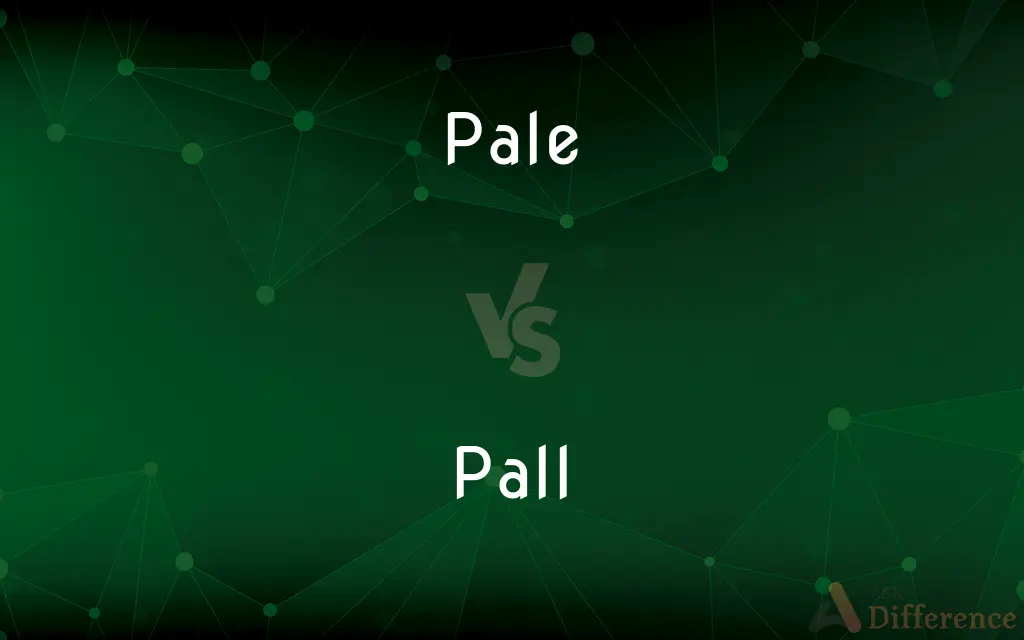Pale vs. Pall — What's the Difference?
By Urooj Arif & Maham Liaqat — Updated on May 19, 2024
Pale refers to a light or washed-out color, while pall refers to a cloth covering for a coffin or a sense of gloom or heaviness.

Difference Between Pale and Pall
Table of Contents
ADVERTISEMENT
Key Differences
Pale describes a light or faded color, lacking intensity. It is commonly used to describe skin tones, colors, or lightness. Pall, on the other hand, can refer to a covering, often a cloth used on coffins, or it can describe a pervasive sense of gloom, heaviness, or a somber atmosphere.
When something is pale, it means it has a light, faint, or subdued color. This term is often used to describe a person's complexion, indicating a lack of color, possibly due to illness or fright. Pall, in contrast, has two primary meanings: it is either a cloth that covers a coffin or something that casts a shadow of sadness or gloom over a situation or place.
Pale can indicate health or environmental conditions, such as pale skin from illness or pale light at dawn. Pall is used more metaphorically or literally to describe covering or atmosphere, such as a pall of smoke over a city or the somber mood at a funeral.
While pale primarily deals with visual aspects, describing color or lightness, pall often deals with mood, atmosphere, or ceremonial coverings, adding a layer of emotional or symbolic meaning.
Comparison Chart
Definition
Light or washed-out color
Cloth for a coffin or a sense of gloom
ADVERTISEMENT
Usage Context
Skin tones, colors, light
Funerals, somber atmosphere
Physical Form
Light, faint color
Cloth or intangible sense
Examples
Pale skin, pale blue sky
Pall of smoke, pall over the gathering
Implication
Lack of intensity or color
Gloom, heaviness, or ceremonial cover
Compare with Definitions
Pale
Washed-out appearance.
His face turned pale when he heard the news.
Pall
Heavy, dark cloud.
A pall of smoke from the fire covered the city.
Pale
Indicating health issues.
She looked pale and tired after the long trip.
Pall
A cover for a coffin, bier, or tomb, often made of black, purple, or white velvet.
Pale
Light in colour or shade; containing little colour or pigment
Choose pale floral patterns for walls
Pall
A coffin, especially one being carried to a grave or tomb.
Pale
Inferior or unimpressive
The new cheese is a pale imitation of continental cheeses
Pall
A covering that darkens or obscures
A pall of smoke over the city.
Pale
Become pale in one's face from shock or fear
I paled at the thought of what she might say
Pall
A gloomy effect or atmosphere
"A pall of depressed indifference hung over Petrograd during February and March 1916" (W. Bruce Lincoln).
Pale
Seem or become less important
All else pales by comparison
Pall
A linen cloth or a square of cardboard faced with cloth used to cover the chalice.
Pale
A wooden stake or post used with others to form a fence.
Pall
See pallium.
Pale
An area within determined bounds, or subject to a particular jurisdiction.
Pall
To cover with or as if with a pall.
Pale
A broad vertical stripe down the middle of a shield.
Pall
To become insipid, boring, or wearisome.
Pale
A stake or pointed stick; a picket.
Pall
To have a dulling, wearisome, or boring effect.
Pale
A fence enclosing an area.
Pall
To become cloyed or satiated.
Pale
The area enclosed by a fence or boundary.
Pall
To cloy; satiate.
Pale
A region or district lying within an imposed boundary or constituting a separate jurisdiction.
Pall
To make vapid or wearisome.
Pale
Pale The medieval dominions of the English in Ireland. Used with the.
Pall
Senses relating to cloth.
Pale
(Heraldry) A wide vertical band in the center of an escutcheon.
Pall
Fine cloth, especially purple cloth used for robes.
Pale
To enclose with pales; fence in.
Pall
A heavy cloth laid over a coffin or tomb; a shroud laid over a corpse.
Pale
To cause to turn pale.
Pall
(Christianity) A piece of cardboard, covered with linen and embroidered on one side, used to cover the chalice during the Eucharist.
Pale
To become pale; blanch
Paled with fright.
Pall
A cloth used for various purposes on the altar in a church, such as a placed]] or drapery covering the front of an altar.
Pale
To decrease in relative importance.
Pall
Senses relating to clothing.
Pale
Whitish in complexion; pallid.
Pall
(archaic) An outer garment; a cloak, mantle, or robe.
Pale
Of a low intensity of color; light.
Pall
(figuratively) Something that covers or surrounds like a cloak; in particular, a cloud of dust, smoke, etc., or a feeling of fear, gloom, or suspicion.
The early election results cast a pall over what was supposed to be a celebration.
A pall came over the crowd when the fourth goal was scored.
Pale
Having high lightness and low saturation.
Pall
(Christianity) Especially in Roman Catholicism: a worn]] over the chasuble.
Pale
Of a low intensity of light; dim or faint
"a late afternoon sun coming through the el tracks and falling in pale oblongs on the cracked, empty sidewalks" (Jimmy Breslin).
Pall
(heraldic charge) A charge representing an archbishop's pallium, having the form of the letter Y charged with crosses.
The flag of South Africa has a green pall
Pale
Feeble; weak
A pale rendition of the aria.
Pall
A feeling of nausea caused by disgust or overindulgence.
Pale
Light in color.
I have pale yellow wallpaper.
She had pale skin because she didn't get much sunlight.
Pall
(transitive) To cloak or cover with, or as if with, a pall.
Pale
(of human skin) Having a pallor (a light color, especially due to sickness, shock, fright etc.).
His face turned pale after hearing about his mother's death.
Pall
(transitive) To make vapid or insipid; to make lifeless or spiritless; to dull, to weaken.
Pale
Feeble, faint.
He is but a pale shadow of his former self.
The son's clumsy paintings are a pale imitation of his father's.
Pall
(intransitive) To become dull, insipid, tasteless, or vapid; to lose life, spirit, strength, or taste.
The liquor palls.
Pale
(intransitive) To turn pale; to lose colour.
Pall
Same as Pawl.
Pale
(intransitive) To become insignificant.
Pall
An outer garment; a cloak mantle.
His lion's skin changed to a pall of gold.
Pale
(transitive) To make pale; to diminish the brightness of.
Pall
A kind of rich stuff used for garments in the Middle Ages.
Pale
To enclose with pales, or as if with pales; to encircle or encompass; to fence off.
Pall
Same as Pallium.
About this time Pope Gregory sent two archbishop's palls into England, - the one for London, the other for York.
Pale
(obsolete) Paleness; pallor.
Pall
A figure resembling the Roman Catholic pallium, or pall, and having the form of the letter Y.
Pale
A wooden stake; a picket.
Pall
A large cloth, esp., a heavy black cloth, thrown over a coffin at a funeral; sometimes, also, over a tomb.
Warriors carry the warrior's pall.
Pale
(archaic) Fence made from wooden stake; palisade.
Pall
A piece of cardboard, covered with linen and embroidered on one side; - used to put over the chalice.
Pale
(by extension) Limits, bounds (especially before of).
Pall
Nausea.
Pale
The bounds of morality, good behaviour or judgment in civilized company, in the phrase beyond the pale.
Pall
To cloak.
Pale
(heraldry) A vertical band down the middle of a shield.
Pall
To become vapid, tasteless, dull, or insipid; to lose strength, life, spirit, or taste; as, the liquor palls.
Beauty soon grows familiar to the lover,Fades in the eye, and palls upon the sense.
Pale
(archaic) A territory or defensive area within a specific boundary or under a given jurisdiction.
Pall
To make vapid or insipid; to make lifeless or spiritless; to dull; to weaken.
Reason and reflection . . . pall all his enjoyments.
Pale
(historical) The parts of Ireland under English jurisdiction.
Pall
To satiate; to cloy; as, to pall the appetite.
Pale
(historical) The territory around Calais under English control (from the 14th to 16th centuries).
Pall
A sudden numbing dread
Pale
(historical) A portion of Russia in which Jews were permitted to live.
Pall
Burial garment in which a corpse is wrapped
Pale
(archaic) The jurisdiction (territorial or otherwise) of an authority.
Pall
Hanging cloth used as a blind (especially for a window)
Pale
A cheese scoop.
Pall
Become less interesting or attractive
Pale
Wanting in color; not ruddy; dusky white; pallid; wan; as, a pale face; a pale red; a pale blue.
Speechless he stood and pale.
They are not of complexion red or pale.
Pall
Cause to lose courage;
Dashed by the refusal
Pale
Not bright or brilliant; of a faint luster or hue; dim; as, the pale light of the moon.
The night, methinks, is but the daylight sick;It looks a little paler.
Pall
Cover with a pall
Pale
Paleness; pallor.
Pall
Cause surfeit through excess though initially pleasing;
Too much spicy food cloyed his appetite
Pale
A pointed stake or slat, either driven into the ground, or fastened to a rail at the top and bottom, for fencing or inclosing; a picket.
Deer creep through when a pale tumbles down.
Pall
Cause to become flat;
Pall the beer
Pale
That which incloses or fences in; a boundary; a limit; a fence; a palisade.
Pall
Lose sparkle or bouquet;
Wine and beer can pall
Pale
A space or field having bounds or limits; a limited region or place; an inclosure; - often used figuratively.
Pall
Lose strength or effectiveness; become or appear boring, insipid, or tiresome (to);
The course palled on her
Pale
A region within specified bounds, whether or not enclosed or demarcated.
Pall
Get tired of something or somebody
Pale
A stripe or band, as on a garment.
Pall
Cloth covering for a coffin.
The coffin was draped with a black pall.
Pale
One of the greater ordinaries, being a broad perpendicular stripe in an escutcheon, equally distant from the two edges, and occupying one third of it.
Pall
Gloomy atmosphere.
A pall of sadness hung over the room after the announcement.
Pale
A cheese scoop.
Pall
Somber mood.
The bad news cast a pall over the celebration.
Pale
A shore for bracing a timber before it is fastened.
Pall
Depressive influence.
The unexpected defeat cast a pall on the team's morale.
Pale
To turn pale; to lose color or luster.
Apt to pale at a trodden worm.
Pale
To make pale; to diminish the brightness of.
The glowworm shows the matin to be near,And 'gins to pale his uneffectual fire.
Pale
To inclose with pales, or as with pales; to encircle; to encompass; to fence off.
[Your isle, which stands] ribbed and paled inWith rocks unscalable and roaring waters.
Pale
A wooden strip forming part of a fence
Pale
Turn pale, as if in fear
Pale
Very light colored; highly diluted with white;
Pale seagreen
Pale blue eyes
Pale
(of light) lacking in intensity or brightness; dim or feeble;
The pale light of a half moon
A pale sun
The late afternoon light coming through the el tracks fell in pale oblongs on the street
A pallid sky
The pale (or wan) stars
The wan light of dawn
Pale
Lacking in vitality or interest or effectiveness;
A pale rendition of the aria
Pale prose with the faint sweetness of lavender
A pallid performance
Pale
Abnormally deficient in color as suggesting physical or emotional distress;
The pallid face of the invalid
Her wan face suddenly flushed
Pale
Not full or rich;
High, pale, pure and lovely song
Pale
Lacking intensity.
The painting had pale, delicate hues.
Pale
Soft, subdued light.
The pale light of dawn began to illuminate the room.
Common Curiosities
What does pale mean?
Light or washed-out in color.
Is pall always related to funerals?
Not always; it can also describe a general sense of gloom or heaviness.
Is pale always related to color?
Primarily, yes, indicating lightness or lack of intensity in color.
What does pall mean?
A cloth covering for a coffin or a pervasive sense of gloom.
How do you use pall in a sentence?
E.g., A pall of grief settled over the town after the tragedy.
Can a mood be pale?
Not typically; moods are more often described as somber, bright, etc.
Can a color be pall?
No, colors are described as pale; pall refers to mood or coverings.
Can an event cast a pall?
Yes, negative events can cast a pall over subsequent activities.
Is pall used in literature?
Yes, often to create a somber or gloomy mood.
Can something be pale and have a pall?
Yes, for example, a pale sky can be under a pall of smoke.
How do you use pale in a sentence?
E.g., Her face was pale from fright.
Is pale used in literature?
Yes, to describe lightness in color or complexion.
Does pale imply sickness?
Often, but not exclusively; it can also describe light colors.
Does pall imply sadness?
Yes, it often implies a gloomy or somber atmosphere.
Can something be both pale and pallid?
Yes, a person's face can be described as both pale and pallid, indicating a lack of color and a sickly appearance.
Share Your Discovery

Previous Comparison
Anger vs. Rile
Next Comparison
Arrow vs. BulletAuthor Spotlight
Written by
Urooj ArifUrooj is a skilled content writer at Ask Difference, known for her exceptional ability to simplify complex topics into engaging and informative content. With a passion for research and a flair for clear, concise writing, she consistently delivers articles that resonate with our diverse audience.
Co-written by
Maham Liaqat












































